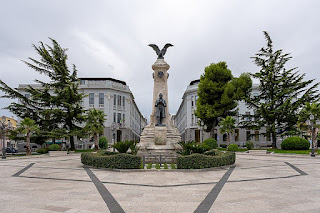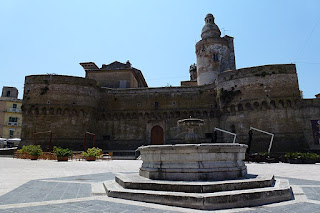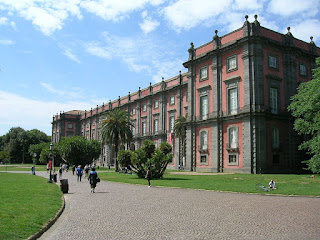Scholarly revolutionary became a leading translator of mediaeval Arabic
 |
| Michele Amari embraced the cause of Italian unification |
Amari published a history in 1842 of the War of the Sicilian Vespers, was a minister in the Sicilian revolutionary government in 1848, and was part of Giuseppe Garibaldi’s revolutionary cabinet in Sicily in 1860.
He embraced the cause of Italian unification and helped prepare Sicilians for the annexation of Sicily by the Kingdom of Sardinia. During his later years, he served as a Senator of the new Kingdom of Italy.
A grandson of the third Count Amari of Sant’Adriano, he grew up in an aristocratic household. The title had been acquired in 1772 by one of his ancestors, who had held the hereditary office of the administrator of the royal tobacco monopoly.
Michele Amari lived with his grandfather in the centre of Palermo after his father, Ferdinando, had financial problems caused by his gambling. Armari was educated in Palermo and one of his teachers was a leading Sicilian historian.
Amari’s father later introduced him to Francophile democratic circles in Palermo and secured him a position at the Ministry of the Interior in 1820.
After his grandfather died, Amari returned to live in his father’s house and he was involved, along with his father, in the uprising of the Carbonari in Palermo. The rebels were demanding Sicilian independence and a liberal constitution.
 |
| Amari served in the governments of Sicily and the unified Italy |
By 1837, Amari had prepared an outline for his book investigating the War of the Sicilian Vespers between 1282 and 1302. The work was interpreted by many people as being a call to overthrow the Bourbon rule in the Kingdom of the Two Sicilies.
Amari was involved in health administration during an outbreak of cholera in 1837 and he was transferred to Naples in 1838, but the book was eventually released in 1842.
The title was deliberately understated to bypass censorship, but it rapidly won an audience in Sicily and on the mainland in Italy. This caused concern to the Neapolitan Government and Amari had to go into exile in Paris, where he moved in French liberal elite circles.
During the 1848 Sicilian revolution, Amari returned to the island to take up the Chair of Law at the University in Palermo. He was elected as a deputy in the Sicilian parliament and became Minister of Finance in the revolutionary government.
After lobbying for the recognition of the Sicilian state in Paris and London, he accepted an academic position at the University of Pisa.
 |
| The Villa Amari in Via Traversa was the family's home in Palermo |
He served as Minister of Education in the Italian Government from 1862 until 1864 and lived at times in Florence, Rome, and Pisa. He died in Florence in 1889 and was later buried in Palermo, at the church of San Domenico.
Having mastered Arabic while living in Paris, Amari was a forerunner for Oriental studies in Italy and became recognised as one of the finest translators of mediaeval Arabic in Europe.
%20(1).jpg) |
| Pasta alla Norma, served in a sauce made from tomatoes and aubergine, is a typical Sicilian dish |
With an area of 10,000 square miles (26,000 sq km), and 620 miles of coastline, Sicily is the largest island in the Mediterranean, just off the toe of Italy’s boot. The ancient ruins, diverse architecture and wonderful cuisine enjoyed by visitors are all testament to the island’s colourful history. It's two biggest cities are Palermo and Catania, while the among the biggest draws for tourists are the cities of the southeast of the island, such as Siracusa (Syracuse), Noto and Ragusa, famous for their stunning Sicilian Baroque architecture, the upmarket resort of Taormina, and the Greek temples at Agrigento. Watching over the east of the island is Mount Etna, a volcano that is still active today.
Travel tip:
Palermo's magnificent cathedral relects the
diversity of architectural style on the island
Sicily’s capital city, Palermo, where Michele Amari was born and is buried, has a wealth of beautiful architecture, plenty of shops and markets, and is home to the largest opera house in Italy, the Teatro Massimo. Amari’s family residence, the baroque Villa Amari, was built in 1720 by the first Count of Armari in Via Traversa in the Piano dei Colli in Palermo. Palermo's architectural styles bear testament to a history of northern European and Arabian influences. The church of San Cataldo on Piazza Bellini is a good example of the fusion of Norman and Arabic architectural styles, having a bell tower typical of those common in northern France but with three spherical red domes on the roof, while the city’s majestic Cathedral of the Assumption of Virgin Mary includes Norman, Moorish, Gothic, Baroque and Neoclassical elements.
Also on this day:
1573: The death of architect Giacomo Barozzi da Vignola
1903: The birth of film director Vittorio De Sica
1911: The death of composer and librettist Gian Carlo Menotti
1990: Italy finished third in Italia '90 World Cup








